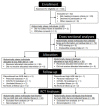A 4-Week Diet Low or High in Advanced Glycation Endproducts Has Limited Impact on Gut Microbial Composition in Abdominally Obese Individuals: The deAGEing Trial
- PMID: 35628138
- PMCID: PMC9141283
- DOI: 10.3390/ijms23105328
A 4-Week Diet Low or High in Advanced Glycation Endproducts Has Limited Impact on Gut Microbial Composition in Abdominally Obese Individuals: The deAGEing Trial
Abstract
Dietary advanced glycation endproducts (AGEs), abundantly present in Westernized diets, are linked to negative health outcomes, but their impact on the gut microbiota has not yet been well investigated in humans. We investigated the effects of a 4-week isocaloric and macronutrient-matched diet low or high in AGEs on the gut microbial composition of 70 abdominally obese individuals in a double-blind parallel-design randomized controlled trial (NCT03866343). Additionally, we investigated the cross-sectional associations between the habitual intake of dietary dicarbonyls, reactive precursors to AGEs, and the gut microbial composition, as assessed by 16S rRNA amplicon-based sequencing. Despite a marked percentage difference in AGE intake, we observed no differences in microbial richness and the general community structure. Only the Anaerostipes spp. had a relative abundance >0.5% and showed differential abundance (0.5 versus 1.11%; p = 0.028, after low- or high-AGE diet, respectively). While the habitual intake of dicarbonyls was not associated with microbial richness or a general community structure, the intake of 3-deoxyglucosone was especially associated with an abundance of several genera. Thus, a 4-week diet low or high in AGEs has a limited impact on the gut microbial composition of abdominally obese humans, paralleling its previously observed limited biological consequences. The effects of dietary dicarbonyls on the gut microbiota composition deserve further investigation.
Keywords: 16S rRNA; RCT; UPLC-MS/MS; alpha diversity; beta diversity; dietary advanced glycation end products; dietary dicarbonyls; differential abundance; gut microbiota.
Conflict of interest statement
The authors declare no conflict of interest. The sponsors had no role in the design, execution, interpretation, or writing of the study.
Figures




References
-
- Scheijen J., Clevers E., Engelen L., Dagnelie P.C., Brouns F., Stehouwer C.D.A., Schalkwijk C.G. Analysis of advanced glycation endproducts in selected food items by ultra-performance liquid chromatography tandem mass spectrometry: Presentation of a dietary AGE database. Food Chem. 2016;190:1145–1150. doi: 10.1016/j.foodchem.2015.06.049. - DOI - PubMed
-
- Cordova R., Knaze V., Viallon V., Rust P., Schalkwijk C.G., Weiderpass E., Wagner K.H., Mayen-Chacon A.L., Aglago E.K., Dahm C.C., et al. Dietary intake of advanced glycation end products (AGEs) and changes in body weight in European adults. Eur. J. Nutr. 2020;59:2893–2904. doi: 10.1007/s00394-019-02129-8. - DOI - PubMed
-
- Mayen A.L., Aglago E.K., Knaze V., Cordova R., Schalkwijk C.G., Wagner K.H., Aleksandrova K., Fedirko V., Keski-Rahkonen P., Leitzmann M.F., et al. Dietary intake of advanced glycation endproducts and risk of hepatobiliary cancers: A multinational cohort study. J. Int. Cancer. 2021;149:854–864. doi: 10.1002/ijc.33612. - DOI - PMC - PubMed
-
- Jiao L., Stolzenberg-Solomon R., Zimmerman T.P., Duan Z., Chen L., Kahle L., Risch A., Subar A.F., Cross A.J., Hollenbeck A., et al. Dietary consumption of advanced glycation end products and pancreatic cancer in the prospective NIH-AARP Diet and Health Study. Am. J. Clin. Nutr. 2015;101:126–134. doi: 10.3945/ajcn.114.098061. - DOI - PMC - PubMed
Publication types
MeSH terms
Substances
Grants and funding
LinkOut - more resources
Full Text Sources
Medical
Miscellaneous

